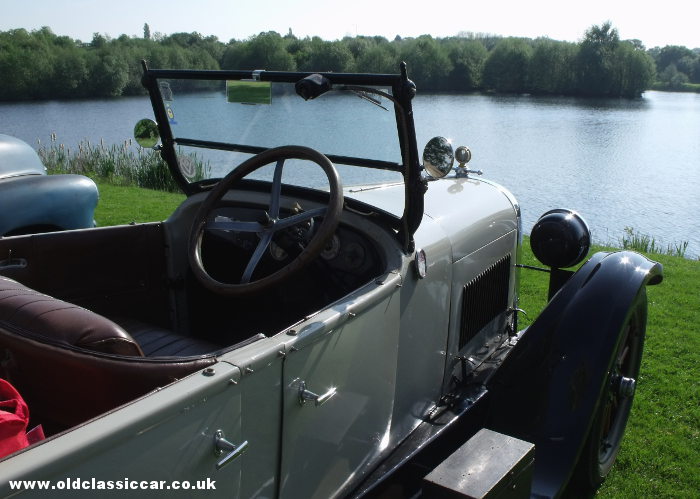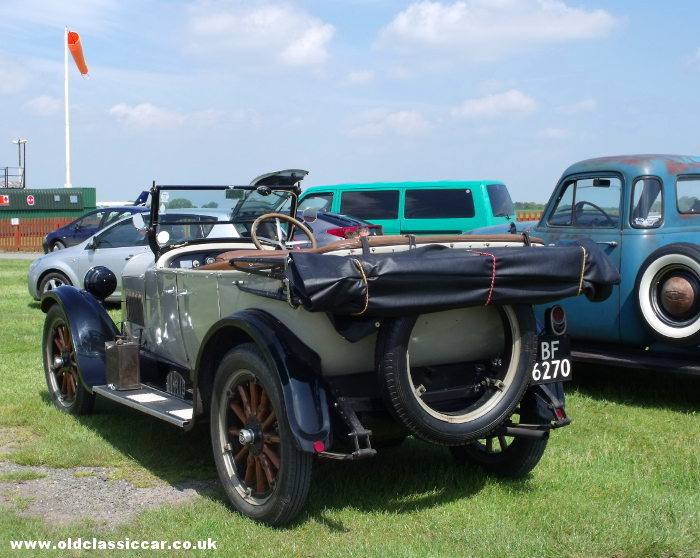
|
Behind the wheel of a vintage car.
Buying a car that actually runs, as opposed to something that needs a heap of work and a large dose of disinfectant before venturing too closely, might appear
to be a very sensible thing to do. I suppose it is. Yet for some reason, most of my finds over the years have fallen into the latter category. A few years ago,
surrounded by a number of near-lost causes and with no idea where to begin, I decided to part with three of these "barn find" ruins and put the proceeds towards buying a pre-war car that ran. My good wife, not the biggest fan of derelict motor-cars, needed gas and air after this momentous decision was announced. Parting with these "gems" was a wrench, but the end goal made it a tolerable if not exactly enjoyable process.
|
Why did I buy it?
The target was to find a car of character, to replace a 1934 Minor saloon. A cracking little car, but with two adults plus one young child and his associated
paraphernalia to house, the compact Morris was becoming a little tight in the accommodation department. Plus I fancied something with a little more grunt if I'm honest, and older. Hunting around found me the 1924 Dodge that I went on to buy. It seemed like a good idea at the time, even though I knew it'd need some re-commissioning work before jolly days out could be planned for. The delights of Eisemann magneto ignition, Autovac-type fuel supply, and single-axle braking systems, were now upon me. Two years, on and off, have been spent getting a handle on these curiosities, and many's the test drive that has been undertaken to try and iron out the Antipodean* gremlins that were discovered, lurking within the Dodge's inner workings.
|
|
(* Despite being a US-built car, it spent most of its life basking in the Australian sunshine)
|

|
|
Out for a spin, just to check things over. Being ex-Australia, this American-built car is righthand drive.
|
|
Lately, after many hours of head scratching and wielding of spanners, its behaviour had begun to improve, to the extent that drives longer than a few miles in
duration might be attempted. News of a short jaunt to a picturesque lakeland setting, followed by an optional road run to a former wartime airfield, where cakes and tea were available, offered the opportunity to take the ninety-year-old tourer on a more extended drive. Sandwiches were packed, and off we went, roof down, bathed in sunlight, but not before a test run of several miles, which was completed on the day prior to departure proper.
|
Driving a car from the 1920s.
Driving the Dodge, and indeed any car of this era, takes a little acclimatising to. No jumping in and flicking a key before setting off at speed. The procedure runs as follows: re-connect the battery beneath the passenger's feet, then pop open the bonnet on the same side and turn on the fuel supply. Retard the ignition, via a lever on the steering column, give it a hint of hand throttle, and press the floor-mounted starter, that actuates the chain-driven "silent" start arrangement. Allow it to churn over for a few seconds, and then - after pulling the choke back an inch or so - flick the mag switch over and - in theory - combustion commences. The gearbox has a heavyweight oil in it, so allowing the car to warm up a little before attempting the highway, is always a good idea. Talking of gears, this particular car has a three-speed gearbox. I've encountered a number of upright Fords that also have three-speeders, but the gear pattern in this Detroit-built automobile is different. The "H" pattern is as follows: first in the usual place (top left). Second is across to the right, then down, while third is right and up (as usual on a four-speeder, but not on a three). Reverse is to the left and back. Additional excitement is offered by having the throttle pedal in the centre, something I first came across in the Minor.
|
|
With the system warmed through a little and the timing now advanced, off we set, in the direction of the lakeside stop. Recent alterations to the ignition timing have improved its abilities no end, and while it's still capable of creating some pretty impressive hold-ups in the rear view mirror, it rolls along quite comfortably at 30-35mph, with sufficient torque on offer from its 3.5 litre four-cylinder engine that downshifts are rarely needed (thankfully). The large wheels, soft springing, well-padded seats and long wheelbase all give the car a very good ride indeed, as it would have needed when traversing the poorly-surfaced roads of 1920s America, or in this car's case those of New South Wales, Australia.
|
To the meeting.
The meeting was organised by a Triumph enthusiast, and as a result there were many TRs of different shapes and sizes, already in place by the time of our arrival. In fact I think we were in the oldest car there. Other pre-war vehicles on display included a very smart Morris 8, a tidy Austin 7 Ruby in daily use, and a very untidy hedgerow-find Ruby, deposited onto a trailer. The Austin's owner hopes to one day resurrect this much-rusted survivor. I doth my cap to his optimism, but rather him than me.
|

|
|
The aforementioned Austin 7 Ruby, and a contemporary rival - the Morris 8 Series 1.
|
|
Much interest surrounded perhaps the newest car that turned up on display, an MGF. Usually I'd barely notice the arrival of such a modern upstart, however the distinctive whistle emanating from its rear compartment - rather than the brrmm brrmm of the usual K-Series lump - led to a swarm of spectators swiftly surrounding the rear-engined roadster. Nestled within its compact engine bay was no petrol engine, but a gas turbine, coupled to a generator and a bank of batteries, making it the only road-legal electric/gas turbine powered car in private hands in the UK apparently. Quite an achievement, and a world away technology-wise from my 1920's mount, and that of dad who was also in attendance, piloting his well-preserved Vanden Plas 1300.
|

|
|
Looking out over Dearnford Lake, in Shropshire.
|
Off to Sleap aerodrome.
Soon it was time to head off again, in convoy with a 1950s Chevrolet pickup truck. The driver of the latter did a sterling job of keeping his truck's speed within reach of my wooden-wheeled machine, and the pootle down to Sleap airfield - home to the Shropshire Aero Club - was completed without incident. The occupant in the Dodge's rear seating area was clearly enjoying the buffetting that those of us up front were protected from thanks to the windscreen (or should that be windshield, whatever), although the said rear seat occupant kept her gushing enthusiasm for such treatment well camouflaged.
|
|
Sleap Aerodrome was originally opened in 1943 as a training unit, initially with Armstrong Whitworth Whitley bombers, later joined by Horsa troop gliders. In November 1944, Vickers Wellingtons took over from the increasingly ancient Whitleys. On our visit, less weighty machines were in evidence - Cessnas for instance, used in pilot training, were typical of the types spotted, however the star "spot" of the day was a super De Havilland Chipmunk trainer, in RAF colours. Coffee and nibbles, consumed on the terrace outside the original wartime control tower, were enjoyed while circuits and bumps were taking place before us. Well worth a visit is the volunteer-run museum, packed to the rafters with aviation relics, many of them dug out of the countryside surrounding
this corner of Shropshire, another good reason to visit this atmospheric airfield.
|

|
|
The preserved DH Chipmunk trainer, spotted at Sleap aerodrome. The Land Rover was pretty tidy too.
|
|
After a couple of hours of general chit-chat, it was time to return to base, the Dodge again in convoy with its younger, Chevrolet-built, friend. For the return ride, junior - aged 6 and a keen
enthusiast of all old vehicles ("new cars are rubbish" he recently proclaimed) - hitched a ride in the pickup, no doubt savouring its heady pace and distinct lack of draughts.
|
|
The longest trip it's made during my ownership, the Dodge made it back without a hiccup. There are still a number of minor jobs to complete, but for ninety years of age, it didn't go badly at all. Perhaps the decision to replace three cars that needed a mountain of work, with one that still needed a fair bit, is beginning to make a little more sense. I just need to make sure now that I don't get tempted by more non-runners....
|

|
|
Parked up at Sleap, the 1920s Dodge and the 1950s Chevrolet 3100 pickup.
|
|
Return to the Other Articles section. A write-up of another day's drive, this time behind the wheel of a 1960s classic, may be found here.
|

|











